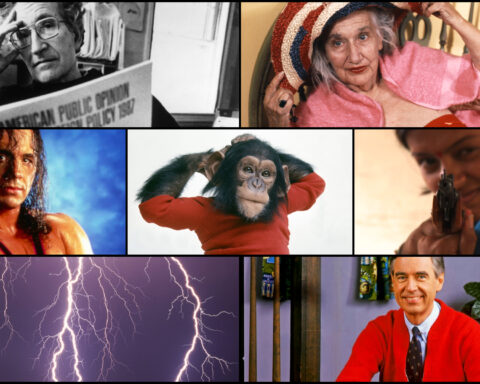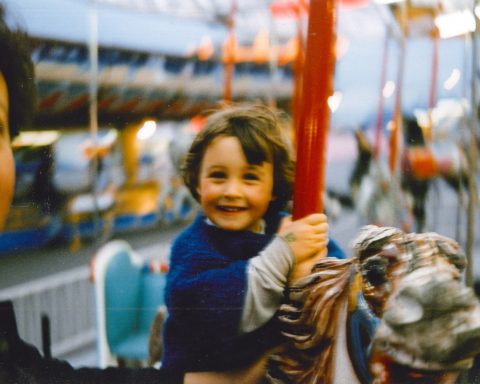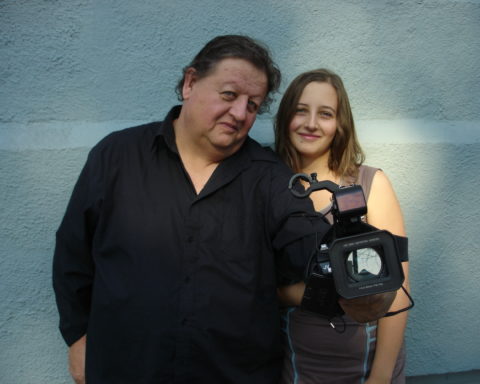MANY PEOPLE CAN ARTICULATE Peter’s enormous influence on and passionate defence of the documentary form. Peter equated documentary with democracy. He has written very eloquently about all of this. But I want to give a unique personal perspective on this singular, brilliant man, the laughing Buddha of documentary.
PETER HAS TOUCHED THOUSANDS of lives with quintessential Wintonick moments at film festivals, conferences, schools and events around the world. Hundreds have had him influence their film with his editing, producing and mentoring. But only a handful of people actually co-directed a film with Peter Wintonick. I feel so blessed to be counted as one of them (His daughter, Mira Burt-Wintonick, is part of this rare club, too.)
Our film, Seeing is Believing: Handicams, Human Rights and the News, is perhaps lesser-known than others he worked on, but it has had a steady and ongoing life, continuing to have an impact and circulating in global human rights activist circles. The film traces the evolution of the power of communications technologies to defend human rights. Just a few months ago, it was translated into Burmese, and Peter showed it in Rangoon at the inaugural Burmese Human Rights Human Dignity festival he helped establish with Aung San Suu Kyi.
PETER WINTONICK ALWAYS just cut through the crap.
Whether he was editing through hundreds of hours of documentary footage, conducting interviews, programming film festivals, mentoring, producing and shepherding others’ embryonic media projects,
conversing into the late hours, telling jokes or even dancing.
He got the beat, he felt the pulse.
He simply got at what mattered, what was funny, poetic, beautiful, truthful, just and respectful and right. The ecstatic truth, he called it. To be with Peter, to make a film with him, was one big road trip. He had an innate and perfect sense of orientation. Physically, politically, intellectually, spiritually.
For him, getting to that truth was not a straight line. He always took the side roads.
At a stopover in Tokyo, after five weeks of filming in the Philippine jungle together, he arranged for us to go to Sony studios to interview the inventor of the amateur handicam. Peter rented a car, got behind the wheel and photographically memorized the map of the city in about 30 seconds. Then he wove through some of the densest traffic on earth, on the left side of the road, with all street signs in Japanese. He got us to that interview, no problem, never looking at the map again, perfectly on time.
He just never got lost.
He could do this in any city he visited. And he visited a lot of them. You could trust and follow him anywhere. His compass pointed true north. He always knew the way.
He perfected the killer itinerary, always paying close attention to those side trips, side roads. We went to the Philippines to film and follow a very political and courageous video activist, Joey Lozano. But there was time for side trips there too. In Davao, Philippines, Peter discovered a park dedicated to the monkey-eating eagle. He also insisted we go visit a colourful Jeepney Factory. In Manila, we had dinner at the “Singing Waiters Restaurant,” where he goaded me into singing with my waiter on stage after dessert.
In Copenhagen, we dropped in on an all-day anniversary party at the commune Christiania, with clowns, live bands and lots of food, all in celebration of anarchy.
Everywhere he went, he found the temples, rivers, beaches, statues, views—holy and sacred places—but he also knew the best bars and the most happening parties.
I also got to see where he got it from. When Peter won the Governor General’s award for Visual and Media Arts in 2006, and we went for dinner at the GG’s mansion, it was his 81-year-old mother who closed down the house. She was the last one standing that night, and she would have stayed up all night to celebrate her son.
PETER HAD COMMITTED to what he called the documentary vow of poverty. He was not in it for the money. At the Hamptons Film Festival, our film had been nominated along with four others for a very hefty cash prize, honouring “films of conflict and resolution.” He disliked competition for many philosophical reasons, so he asked me if we could make a pact with all the filmmakers to agree that no matter who won, we would all split the money equally. We approached them all, and after careful thought, each of the filmmakers said no, except for Peter’s dear friend Anand Patwardhan, who loved the idea.
Peter was, of course, joking; he never thought we’d win. He just wanted to stir things up.
So it really was a surprise for all of us when Pete and I got called to the stage that night to claim the money! All of it! Wow! Peter tore up the dance floor that night. And bright and early the very next morning, he took Anand and me on another one of his side road trips, with the top down in a borrowed convertible VW Rabbit, the wind caressing our hair, speeding down a beach road for a bacon and eggs breakfast at a seaside diner he had heard about in the area.
We travelled a lot to make the film, and then to screen it.
Over the decade, we saw each other often, but our paths took different turns. I gravitated towards new media, in a direction he had pointed me, with his visionary understanding of and early important work on the role of the digital revolution in documentary. He slowly returned to film and, in particular, cinema verité: producing, mentoring, programming and guiding highly cinematic, theatrical films.
In the last days of Peter’s life, as we gathered around him at his bedside, I received the remarkable gift of joining in on one last Wintonick road trip. He was nearing the end, but he was as lucid, funny, powerfully honest and profoundly spiritual as ever.
On his deathbed, he made us laugh, he got married, he danced and he got us closer to the truth. In those last days, one more time, trusting that perfect internal compass of his, he showed us the way life is to be lived to the last defining moment. With humanity, dignity and joy.
Peter had bags of tricks. He was tireless and didn’t sleep much. He said:
- To really see the edit of a film, watch it from the back of the cinema
- When you think you’re finished editing a film, go and watch all your footage over again
- Always board a plane at the very last moment
- Focus-group your rough cut and listen to what audiences say the problems are, but the solutions are yours alone as the director to find
- Eat your lunch outside in the sunshine
- Save your film festival badges and all business cards











